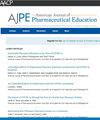培养药学学生的倡导:课程整合与评估策略。
IF 3.5
4区 教育学
Q1 EDUCATION, SCIENTIFIC DISCIPLINES
引用次数: 0
摘要
目的:根据2022年COEPA的要求,探讨学生药师倡导技能的教学和评估。研究结果:COEPA将倡导归类为一种应该发展的技能,以提高患者护理和专业水平。这是2013年CAPE结果的一个变化,当时的重点是为患者争取权益。已经发表了几篇思想论文,呼吁增加倡导培训,但关于如何教授和评估倡导的出版工作有限。在这篇对已发表文献的回顾中,提供了药剂学项目如何纳入和评估宣传的例子。从历史上看,教学倡导及其原则被置于核心课程内容、选修课程和/或联合课程中,与之相关的技能评估有限。为了支持更加注重在专业和人口中开展宣传,建议将宣传中使用的变革模式的教学纳入其中。详细介绍了三种现有模型的示例。摘要:倡导是一种技能,是推进患者护理和专业方向的核心。目前有有限的外部验证工具来测试学生是否理解倡导是什么以及如何进行倡导。应该探索进一步发展教学和评估工具,以帮助为所有学生药剂师提供这一技能的共同基础。本文章由计算机程序翻译,如有差异,请以英文原文为准。
Fostering Advocacy in Student Pharmacists: Strategies for Curricular Integration and Assessment
Objectives
This study aimed to discuss teaching and assessment of advocacy skills in student pharmacists as called for in the American Association of Colleges of Pharmacy 2022 Curriculum Outcomes and Entrustable Professional Activities.
Findings
The American Association of Colleges of Pharmacy 2022 Curriculum Outcomes and Entrustable Professional Activities categorize advocacy as a skill that should be developed to advance patient care and the profession. This is a change from the 2013 Center for Advancement of Pharmacy Education outcomes, in which the focus was on advocating for patients. Several thought papers have been released calling for an increase in advocacy training, but there has been limited published work on how advocacy is taught and assessed. In this review of published literature, examples of how pharmacy programs have incorporated and assessed advocacy are provided. Historically, teaching advocacy and its principles has been placed in the core curriculum content, elective courses, and/or cocurriculum, with limited assessment of skills related to advocacy. To support the greater focus on developing advocacy skills within the profession and among patient populations, it is recommended to incorporate the teaching of advocacy-related models of change into education curricula. Examples of 3 existing models are detailed.
Summary
Advocacy is a core skill set for advancing patient care and shaping the direction of the profession. There are currently limited external validation tools to test if students understand what advocacy is and how to perform advocacy. Further development of teaching and evaluation tools should be explored to help provide a common foundation of this skill set in all student pharmacists.
求助全文
通过发布文献求助,成功后即可免费获取论文全文。
去求助
来源期刊
CiteScore
4.30
自引率
15.20%
发文量
114
期刊介绍:
The Journal accepts unsolicited manuscripts that have not been published and are not under consideration for publication elsewhere. The Journal only considers material related to pharmaceutical education for publication. Authors must prepare manuscripts to conform to the Journal style (Author Instructions). All manuscripts are subject to peer review and approval by the editor prior to acceptance for publication. Reviewers are assigned by the editor with the advice of the editorial board as needed. Manuscripts are submitted and processed online (Submit a Manuscript) using Editorial Manager, an online manuscript tracking system that facilitates communication between the editorial office, editor, associate editors, reviewers, and authors.
After a manuscript is accepted, it is scheduled for publication in an upcoming issue of the Journal. All manuscripts are formatted and copyedited, and returned to the author for review and approval of the changes. Approximately 2 weeks prior to publication, the author receives an electronic proof of the article for final review and approval. Authors are not assessed page charges for publication.

 求助内容:
求助内容: 应助结果提醒方式:
应助结果提醒方式:


